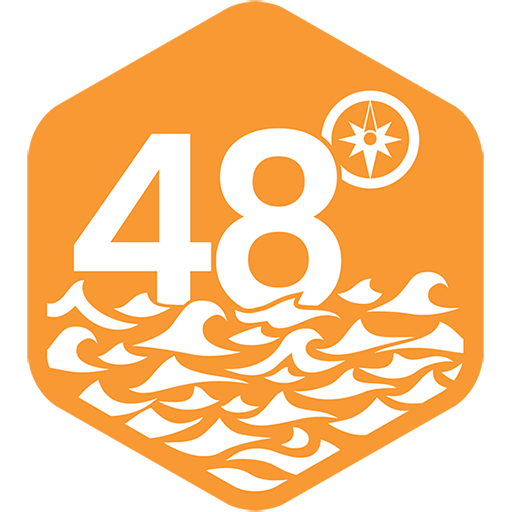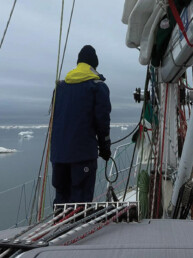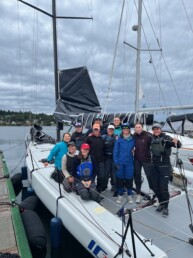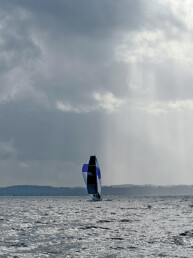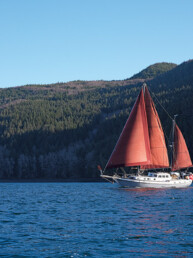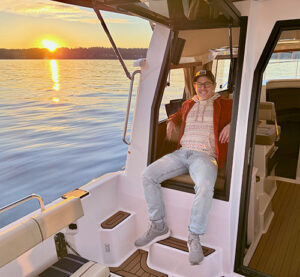 “Joe, I’m buying a boat! Am I crazy?” The excitement from my friend Dennis was electric coming through the phone. It wasn’t a huge surprise, I know he’d been looking somewhat seriously for a long time, but crossing the bridge into actual boat ownership is still huge. What boat? “A Ranger Tug R-25.” Awesome! I congratulated Dennis and told him how thrilled I was for him, how eager I was to spend some time on the boat and, of course, we both knew I might want to do a boat test article about it. So it was that I recently got out on the Ranger Tugs R-25 for the first time.
“Joe, I’m buying a boat! Am I crazy?” The excitement from my friend Dennis was electric coming through the phone. It wasn’t a huge surprise, I know he’d been looking somewhat seriously for a long time, but crossing the bridge into actual boat ownership is still huge. What boat? “A Ranger Tug R-25.” Awesome! I congratulated Dennis and told him how thrilled I was for him, how eager I was to spend some time on the boat and, of course, we both knew I might want to do a boat test article about it. So it was that I recently got out on the Ranger Tugs R-25 for the first time.
Ranger Tugs are ubiquitous in the waters of the Salish Sea, and they’re highly desirable and beloved with good reason. The local company builds their line of versatile cruising boats in Auburn, offers an extensive training program for new owners, and helps facilitate a remarkable community among their fans. That community extends beyond the bounds of the company itself to a network of resources like the website Tugnuts.com and several YouTube channels. But these connections would be nothing without the boats, and Ranger Tugs—which range from 23 to 43 feet—all offer something ideal for Pacific Northwest cruisers.
While I’m certainly accustomed to seeing Ranger Tugs on the water and tied-up at docks around the region, with my background primarily in sailing, I was not intimately familiar with their line, or the R-25 in particular. I’ll tell you, I have certainly enjoyed learning more about the boat and look forward to more time aboard it. The current R-25 is an evolution of the classic Ranger Tugs 25 that had an inboard diesel engine, and now the boat boasts a powerful Yamaha 250 hp outboard and much higher top-end speed capability.
The design indicates its intended versatility. The R-25’s hullshape is built to accommodate the burlier power source with speed, but its planing hull shape is balanced by the concurrent commitment to its impressive interior volume for its size. The boat indeed lives large, with its cushy pilothouse, enclosed head, and cozy V-berth that was plenty big for my 6-foot frame. Yet, the R-25 is also narrow enough (8’6” beam) and light enough (6,500 dry weight) to be trailered behind most modern half-ton pickups without special permits (verify specs for safe towing).
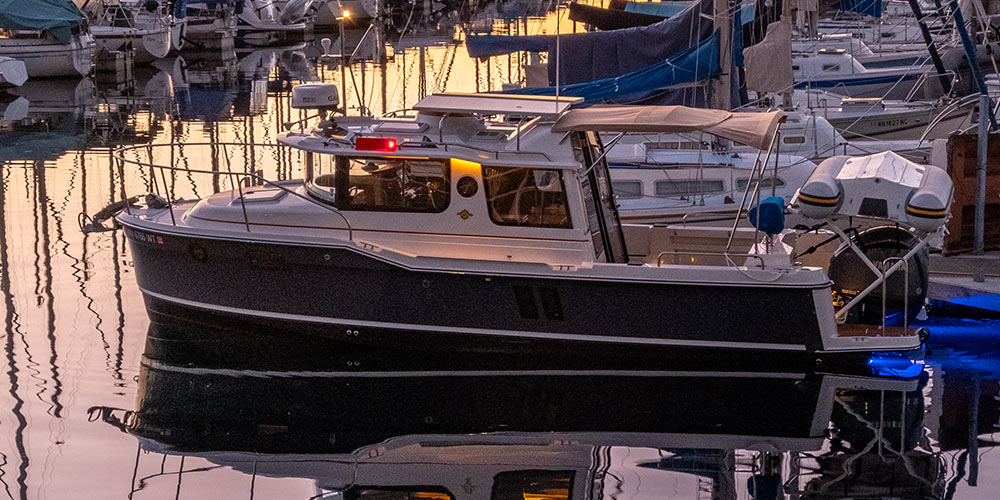
Stepping aboard Dennis’s R-25, which is a 2024 model that he found on the used market, I was reminded this is not a large boat. It’s plenty stable, but it still moved under my weight when I clambered into the cockpit. Once aboard, however, one can understandably forget it’s on the smaller side. Like all Ranger Tugs, the aft cockpit is a nice, open area covered in foot-friendly foam decking—as ready for fishing as it is entertaining—but the allocation of space between interior and exterior is a nod to the manufacturer’s drizzly environs. As I say in every review, all boat design is a compromise, and Ranger has clearly found an excellent formula for the balance between indoor and outdoor living, especially in this corner of the world.
I was again reminded of the R-25’s comparatively small size as we shoved off. The boat was light enough to be easily walked back and pushed away from the slip by hand, though that’s functionally unnecessary as the bow thruster enables great tight-quarter maneuverability. Its ease of handling belies the fact that it’s actually a bit bigger than the model name suggests—with the motor down, the length is 28’ 5”. With its narrow beam, one part of the boat that’s not larger than expected, and another indication of the focus on interior space, I found the side-decks are quite narrow as I ventured forward to bring in fenders and docklines; but luckily, there are great handrails to rely on.
Once out on Puget Sound, we explored the possibilities afforded by a nicely designed, fast cruising boat. With Dennis in the captain’s chair, I hopped on the settee bench in forward-facing orientation (both seat backs hinge so you may sit facing either direction), and he talked me through it all as we brought the boat casually up on plane. The range of ways you might use the R-25 is incredible. You could treat it more like a trawler and sip fuel at 7 knots and double your range; or you could go hammer fully down, as we did at one point. This brought our speed just above 30 knots in one foot wind-chop while dropping fuel efficiency down to 1.2 miles per gallon at 5500 RPM. But the way most R-25 owners recommend driving it is in a fuel-efficient sweetspot around 4200 RPM, in our conditions that meant planing at 24 knots, and the fuel economy was pegged at 2.1 miles per gallon. The R–25 has a 99-gallon fuel tank so in this easy planing mode, you could hypothetically go just over 200 miles. Leaving a 10% reserve, which is common in powerboats, the range at that speed remains a respectable 187 miles.
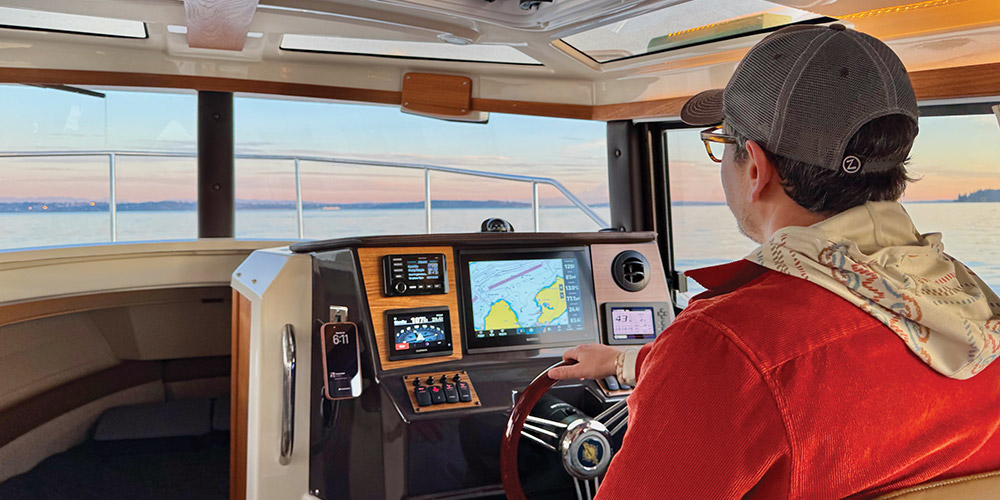
As we worked the boat through its paces, I was impressed by how quiet it was. With doors and windows closed in sweetspot mode, I measured only 78 decibels—about the noise level of a washing machine or busy dishwasher. That number only went up to 85 decibels with everything open and the outboard at full cry.
The R-25’s way through the small wind chop was also smoother than I expected. It didn’t offer the wave-flattening feel of a heavy deep-v hull built for big seas, but I was struck by how much more comfortable the ride was than some smaller powerboats I’ve been on. No need for mouthguards or suspension seats here.
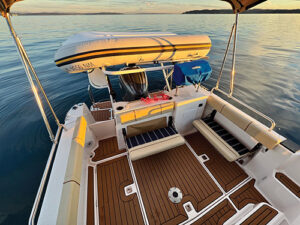
and the dinghy mount is innovative.
It wasn’t a surprise so much as a delight to explore the comfortable interior. Everything about the Ranger was nice, but also hinted at the boat’s broad appeal and relative accessibility. Compared to many higher-end alternatives, this is quite an affordable boat. Efficiency is clearly key, but true sacrifices are few. I noted little things that would likely be more robust on a boat that cost twice as much, but it all struck me as functional and well-considered. I’m certain that those who use the boat regularly would happily employ all aspects of the R-25 without concern.
I learned from Dennis about the tradition of modifying and upgrading these little boats, guided in part by the very enthusiastic and invested community of other Ranger Tugs owners. He had high praise for his boat’s previous owner, who had invested in upgrades like an extra solar panel and a lithium battery with even more capacity than the R-25’s standard LiFePO4 battery, as well as the factory option of the dinghy lift system designed and built by Ranger Tugs, which is raised and lowered by a removable block and tackle. As for other upgrades, Dennis is eyeing a different propeller, a full cockpit enclosure, and is still evaluating whether the auto-trim tabs are right for him and his use-case. He’s already leveled up the sound system, too.
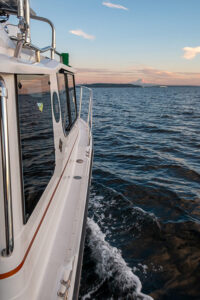 We crossed the Sound in minutes and settled down lazily adrift near Indianola, relaxing and catching up. We opened the big hinging window on the salon’s aft bulkhead. Testing out the aft-facing settee under that open window in what Dennis called “the best seat in the house” with Mount Rainier on colorful display to one side and a vibrant October sunset over the Olympics to the other, I thought about all this boat could do in this region. While most boats could do exactly what we were doing at that moment—it was all just so pleasant on this one. Moving around the single level between the cockpit and salon, lounging in the stowable hinging cushioned cockpit seats, enjoying the protective cover from sun and weather while still drinking-in the open-air feel—the design elements work in harmony. The boat just makes sense. Importantly, it was also in-reach for a peer who, though a smart professional, has a very normal job and way of life. The R-25 fits perfectly.
We crossed the Sound in minutes and settled down lazily adrift near Indianola, relaxing and catching up. We opened the big hinging window on the salon’s aft bulkhead. Testing out the aft-facing settee under that open window in what Dennis called “the best seat in the house” with Mount Rainier on colorful display to one side and a vibrant October sunset over the Olympics to the other, I thought about all this boat could do in this region. While most boats could do exactly what we were doing at that moment—it was all just so pleasant on this one. Moving around the single level between the cockpit and salon, lounging in the stowable hinging cushioned cockpit seats, enjoying the protective cover from sun and weather while still drinking-in the open-air feel—the design elements work in harmony. The boat just makes sense. Importantly, it was also in-reach for a peer who, though a smart professional, has a very normal job and way of life. The R-25 fits perfectly.
Soon, I hopped on the helm, and gave the R-25 a thorough run. Especially in the protected flat water, the boat thrived. So smooth, so easy to drive, so effortless to get up on plane, so fun to turn and maneuver. Going through our own wake reinforced the notion that most folks won’t be happy bashing into steep chop on the R-25, but as I regained the efficient, planing sweetspot and set the autopilot, I suggested, “Friday Harbor? We can be there in 2.5 hours!”
Though the R-25 would be most comfortably employed as a cruising vessel for a couple—as Dennis will use his—or a small family, there are actually accommodations for up to six. The settee table lowers into a double berth, and there’s a compartment below it that Dennis referred to as “the cave” where you can sleep two (the cave is likely a better option for children than adults, and possibly best as storage). There is some impressive additional storage in numerous locations especially under the cockpit sole, and with Dennis’s solar array and lithium set-up, he’ll be good for a week away from the dock. He’s already used the shower and is building his understanding of all the other systems he’ll need for cruising—from the windlass to the galley. Longer term adventures are obviously part of the dream, but a quick jaunt with friends like the one we were enjoying is every bit as enticing for him.
Of course I’m biased, Dennis is my pal and this is his cool new boat, but I honestly liked it… a lot. I see the appeal and appreciate Ranger’s successful execution of its goals with the R-25. I understand why these boats are so popular. And I bet if you tried one, you would too.
Joe Cline has been the Managing Editor of 48° North since 2014. He and his family live in Edmonds, Washington.
Joe Cline
Joe Cline has been the Managing Editor of 48° North since 2014. From his career to his volunteer leadership in the marine industry, from racing sailboats large and small to his discovery of Pacific Northwest cruising —Joe is as sail-smitten as they come. Joe and his wife, Kaylin, have welcomed a couple of beautiful kiddos in the last few years, and he is enjoying fatherhood while still finding time to make a little music and even occasionally go sailing.
